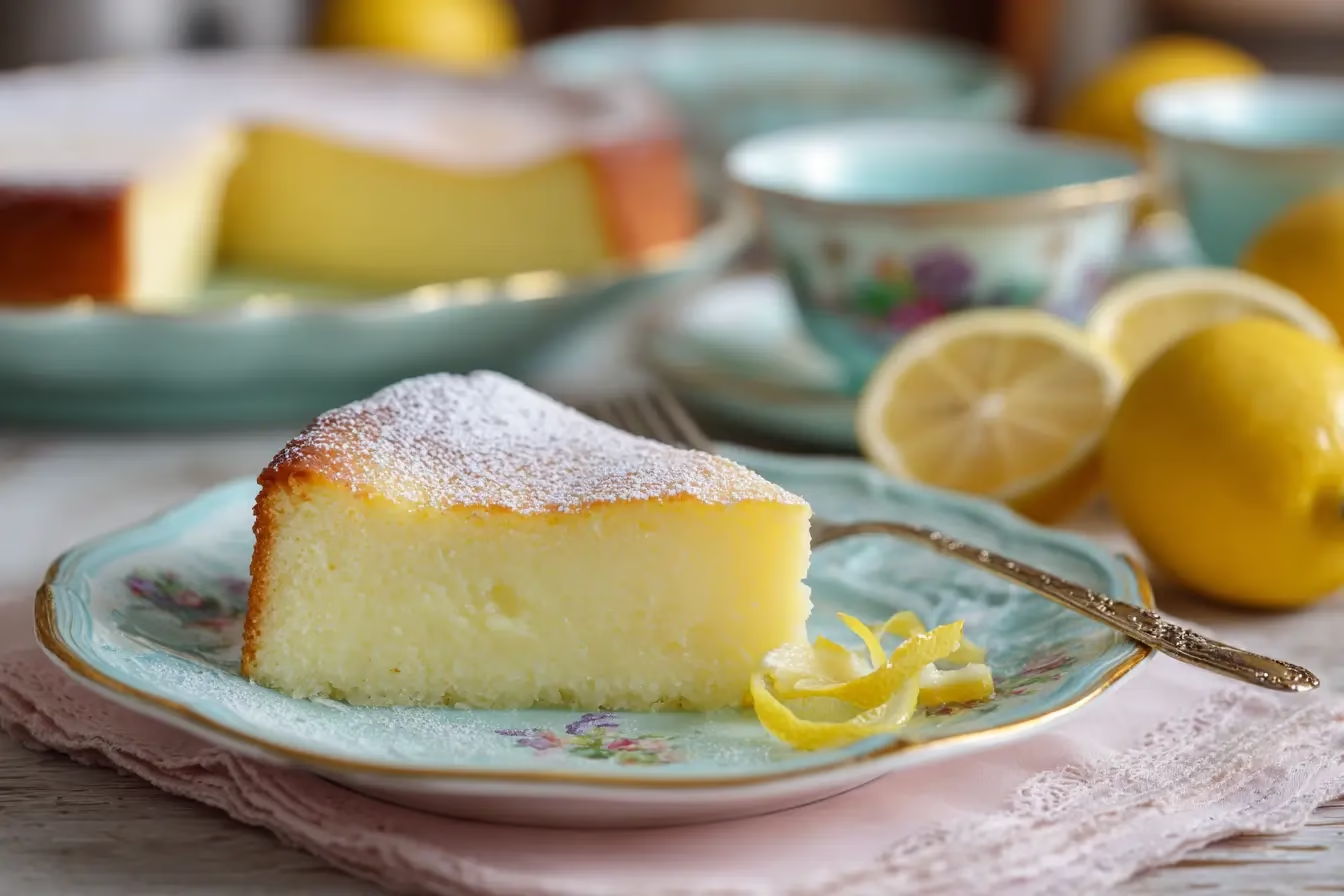Let’s dive into a slice of sunshine, shall we? This Lemon Custard Cake brings together the lightness of whipped egg whites, the tang of fresh lemon juice and zest, and the comforting creaminess of a custard-cake hybrid. Picture this: a cake that bakes into three beautiful layers — a fluff-light top, a smooth creamy middle, and a custardy base. As a food blogger who loves easy but elegant desserts, I’m totally smitten with how this one hits all the right notes. It’s luscious, bright, and the perfect finish to a family dinner or weekend brunch.
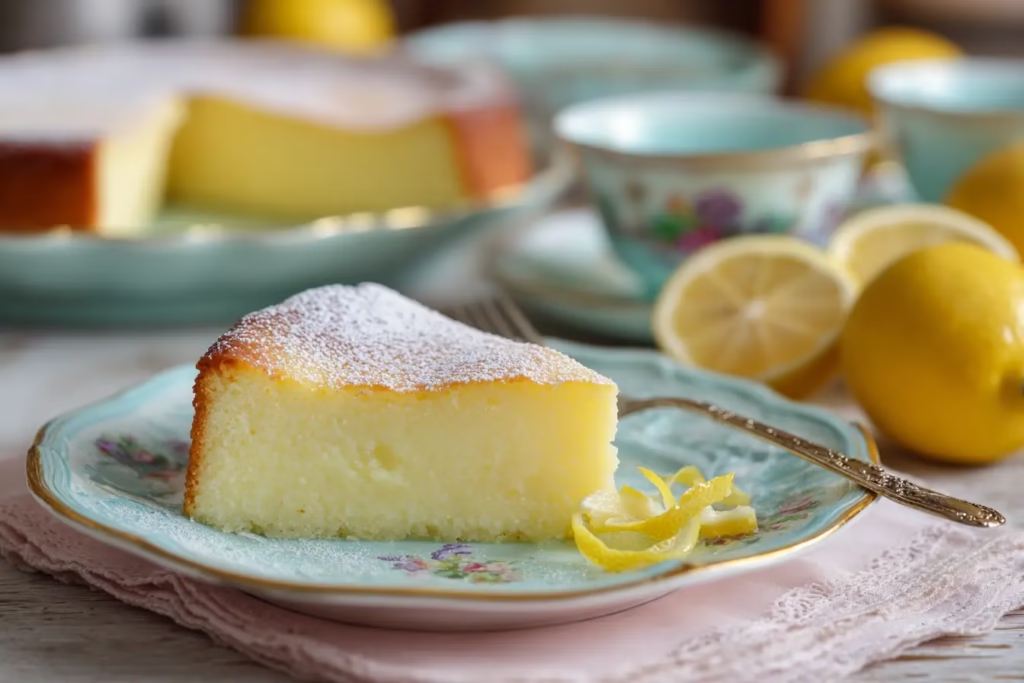
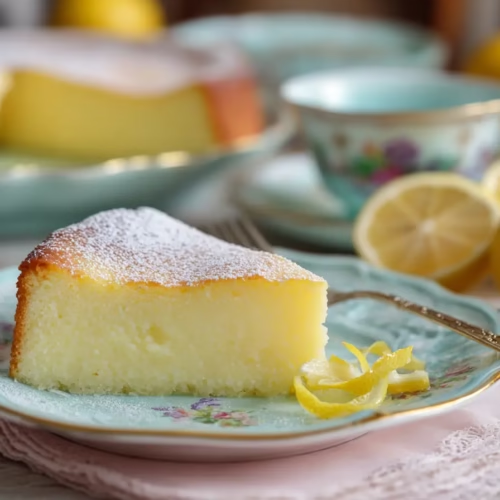
Lemon Custard Cake
Ingredients
- 4 large eggs, separated at room temperature
- ¼ teaspoon cream of tartar optional, for stabilizing egg whites
- ¾ cup granulated sugar
- ½ teaspoon kosher salt or ⅓ tsp table salt
- ½ cup unsalted butter, melted and cooled
- 1 teaspoon vanilla extract or paste
- ¾ cup all-purpose flour, sifted
- ¼ cup fresh lemon juice about 2 large lemons
- 2 tablespoons finely grated lemon zest from about 2 large lemons
- 1 ¾ cups whole milk at room temperature
- powdered sugar for dusting, optional
Instructions
- Preheat oven to 325°F (165°C). Line an 8×8-inch baking pan with parchment paper.
- Separate the eggs, placing whites in a clean mixing bowl. If using, add cream of tartar. Whip on medium-high until stiff peaks form (about 3–5 minutes). Transfer to another bowl.
- In the same bowl, add yolks and beat until foamy (about 1 minute). Gradually add sugar and beat until pale and creamy (2–3 minutes).
- Add salt, melted butter, and vanilla. Mix until fully incorporated.
- Add sifted flour and mix on medium-low until smooth.
- Add lemon juice and zest. Slowly pour in milk while mixing until fully combined. Scrape down the bowl.
- Gently fold in the whipped egg whites in three additions. Do not overmix — a few streaks are okay.
- Pour the thin batter into the prepared pan. Bake for 45–55 minutes, until top is golden and center jiggles slightly.
- Cool completely at room temperature. Cover and refrigerate for at least 1 hour, preferably overnight.
- Cut into 9 squares. Dust with powdered sugar if desired. Serve chilled or at room temperature.
Notes
Nutrition
Why this recipe is great
What makes this Lemon Custard Cake stand out? First off, the texture is what makes it magical. While many cakes are simply cake, this one transforms during baking into three layers: airy cake, creamy custard, solid base. One food blog called it “‘magic’ because … one simple batter transforms into … a light and fluffy top, a rich creamy middle, and a solid custard base.” Nerds with Knives
That trifecta means you get a little something for everyone: cake lovers, custard fans, and lemon-obsessed folks.
Second, it uses everyday ingredients — eggs, sugar, butter, flour, milk, and lemons — so it’s accessible. No exotic components, no scary techniques.
Third, the flavor: bright, zesty lemon cut by the richness of butter and milk. It’s refreshing yet comforting — ideal for those times when you want dessert without feeling weighed down.
And because I know you love tips for your audience: this dessert also stores well (more on that below), and it can be made ahead (say, the night before) so you’re not scrambling last minute when guests arrive.
Ingredients breakdown (with substitutions)
Here’s a breakdown of what you’ll need (based on the recipe “Magic Lemon Custard Cake”) and some friendly substitutes if you’re playing around:
- 4 large eggs, room temperature — The eggs are essential: whites create the lift; yolks enrich the batter.
- ¼ teaspoon cream of tartar (optional) — Helps stabilize the egg whites for better volume. If you don’t have it, you can skip it and still get good results, though slightly less stable.
- ¾ cup sugar — Standard granulated sugar gives the sweet backbone. If you want a lighter sweet profile, you could try ½ cup but your layers may shift a little.
- ½ teaspoon kosher salt — Just a pinch of salt brings out depth in flavor. You can use table salt (⅓ teaspoon) if that’s what you have.
- ½ cup unsalted butter, melted and cooled (1 stick) — The melted butter helps the custard base and sets the richness. If you only have salted butter, reduce the kosher salt a bit or omit the extra salt.
- 1 teaspoon vanilla paste or extract — Optional but adds a lovely background note.
- ¾ cup all-purpose flour, sifted — Sifting helps keep the batter light. You could try whole wheat pastry flour (½ substitution) for a slightly nuttier taste, but expect a denser cake.
- ¼ cup lemon juice (≈ 2 large lemons) — Fresh is highly recommended for the brightest lemon flavor. Bottled juice will work in a pinch, but you’ll lose some brightness.
- 2 tablespoons finely grated lemon zest (≈ 2 large lemons) — The zest adds aromatic oils — don’t skip this! If lemons are small, you could use 3.
- 1 ¾ cups whole milk, room temperature — The whole milk lends creaminess. If you want a lighter version, you could try 2% milk (though texture may be slightly less rich).
- Powdered sugar, for dusting (optional) — Purely decorative, but adds a nice finishing touch.
Substitution summary:
- For a lighter version: use 2% milk, reduce sugar slightly, maybe use a low-fat butter substitute (but texture will differ).
- For gluten-free: you could experiment with a 1:1 gluten-free flour blend, but results may vary and the custard base might shift.
- For a dairy-free twist: replace milk with a creamy non-dairy milk like oat or almond, and use a vegan butter substitute — but expect a slightly different flavor and texture.
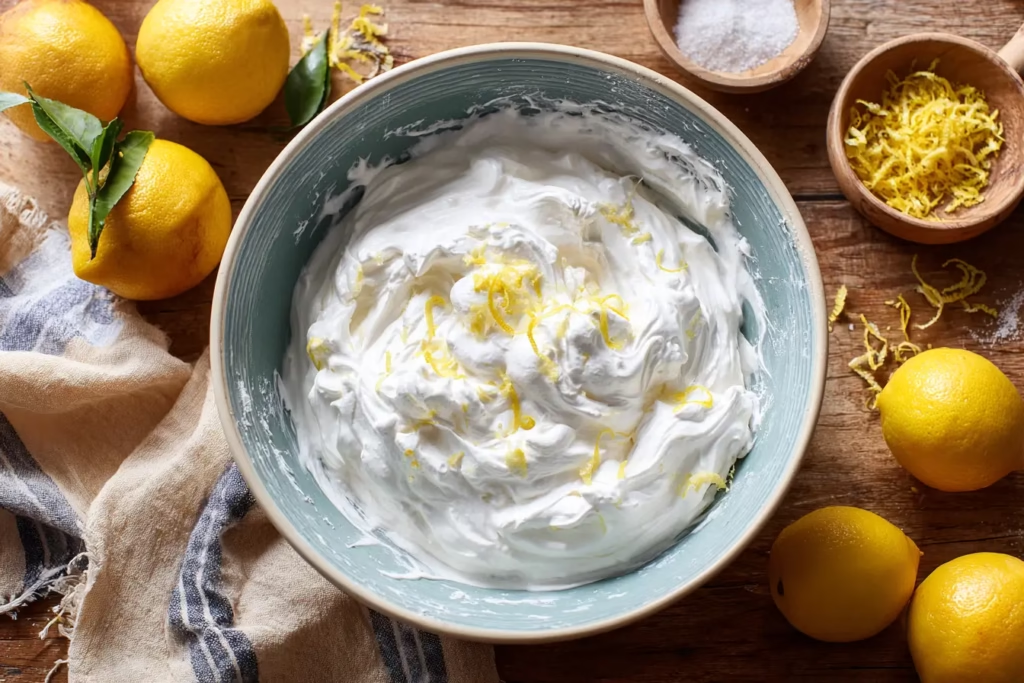
Step-by-step instructions
- Preheat your oven to 325 °F (165 °C) and position a rack in the middle. Line an 8×8-inch baking pan with parchment paper.
- Separate the eggs carefully: place the whites in a clean stand-mixer bowl fitted with a whisk attachment (make sure no yolk sneaks in). If using, add the cream of tartar. Whip on medium-high until stiff peaks form (about 3-5 minutes). Transfer the whipped whites to a separate bowl and set aside.
- Using the same mixing bowl (no need to wash it), add the yolks and whisk on medium-high for about 1 minute, until they become foamy.
- With the mixer running, gradually drizzle in the sugar. Continue whisking until the yolks become creamy and pale (about 2-3 minutes).
- Add the kosher salt, melted and cooled butter, and vanilla extract. Beat for another 1-2 minutes until everything is well incorporated.
- Switch to the paddle attachment. Add the sifted flour and mix on medium-low speed until the batter is smooth and evenly combined.
- Add the lemon juice and finely grated zest. Then slowly pour in the milk while mixing, ensuring everything is fully incorporated. Stop the mixer, use a silicone spatula to scrape the sides and bottom of the bowl for even mixing.
- Remove the bowl from the mixer. Gently fold in the reserved egg whites in three additions: add about a third of the whites, fold gently until just incorporated, then repeat with the next two additions. Don’t overmix — it’s okay if you see a few streaks of white.
- Pour the batter into the prepared baking pan. Bake for 45 to 55 minutes, or until the top is lightly golden and the center jiggles just slightly when gently shaken. (If the jiggle is too loose, extend bake time by a few minutes.)
- Let the cake cool completely at room temperature. Then cover the pan and refrigerate the cake for at least 1 hour, or preferably overnight, to allow the custard layers to fully set.
- When ready to serve: remove the cake from the pan, slice into 9 squares, dust generously with powdered sugar (if using), and serve chilled or at room temperature.
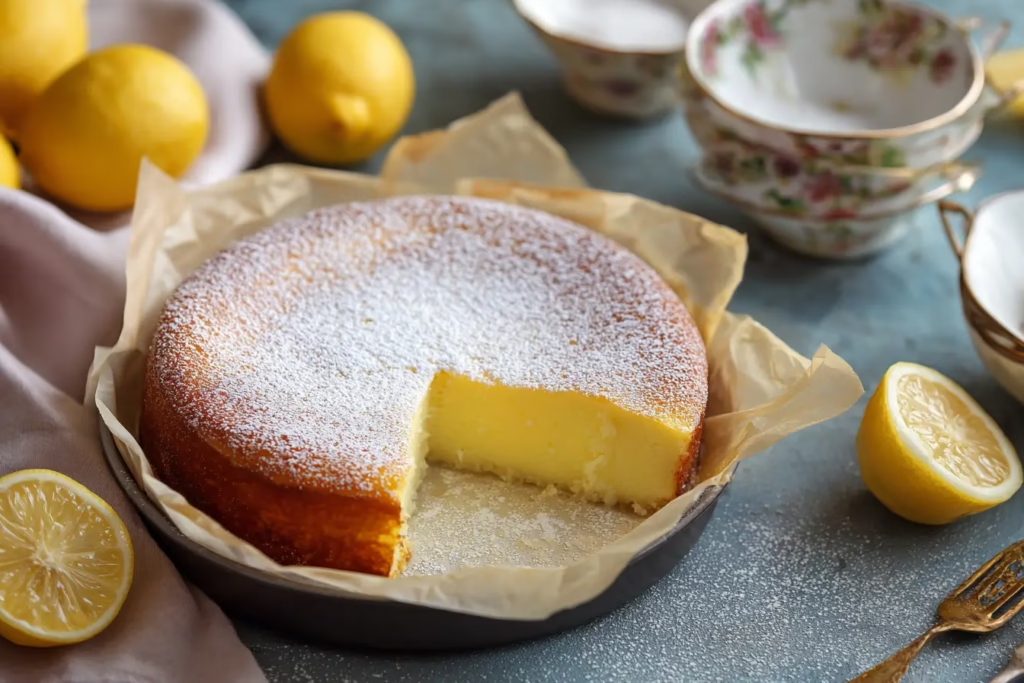
Variations, storage & serving ideas
Variations:
- Berry Lemon Custard Cake: Gently fold in ½ cup fresh blueberries or raspberries just before pouring into the pan for bursts of fruit.
- Lavender-Lemon Custard Cake: Infuse the milk with 1 teaspoon dried culinary lavender, strain, then proceed with the milk to give a subtle floral note.
- Coconut Lemon Custard Cake: Replace ¼ cup of the flour with finely shredded unsweetened coconut and sprinkle 2 tablespoons extra on top before baking for a tropical twist.
- Gluten-free version: Try using a 1:1 gluten-free flour blend, though note you might need slightly less milk or slightly more flour to compensate for absorption differences.
Storage:
- Cover the cake tightly and refrigerate for up to 4–5 days. The custard layers stay firm and the flavor actually improves after a day.
- To freeze: Once chilled, cut into squares, wrap each square individually in plastic wrap, then freeze in an airtight container for up to 3 months. Thaw in the fridge overnight.
- When serving cold, you may want to let it sit at room temperature for 10–15 minutes so the custard softens slightly for a creamy texture.
Serving ideas:
- Serve each square with a dollop of lightly whipped cream and a thin lemon slice for garnish.
- Pair it with a fresh berry compote (warm or chilled) for contrast.
- For a brunch spread, cut into smaller squares (12 instead of 9) and serve alongside fresh brewed coffee or iced tea.
- For an elegant dinner party, top each square with a mint sprig and a dusting of powdered sugar right before serving.
FAQs
Lemon Custard Cake – FAQs
Quick AnswersQ Can I use low-fat milk instead of whole milk?
Q Why did my top layer crack or separate from the custard?
Q Can I make this ahead of time for a party?
Q What’s the best way to re-warm or serve leftovers?
Final Note
If you love this recipe, you might also enjoy some of my other citrus-sweetened favorites: check out the fun Lemon Fluff, the indulgent Lemon Cream Cheese Dump Cake or the comforting Magic Lemon Cobbler on my blog. For more dessert inspiration and visuals, follow me on Pinterest at myflavorrecipes on Pinterest and on Facebook at MyFlavorRecipes Facebook Page. Happy baking—and may your kitchen be filled with lemony joy!

